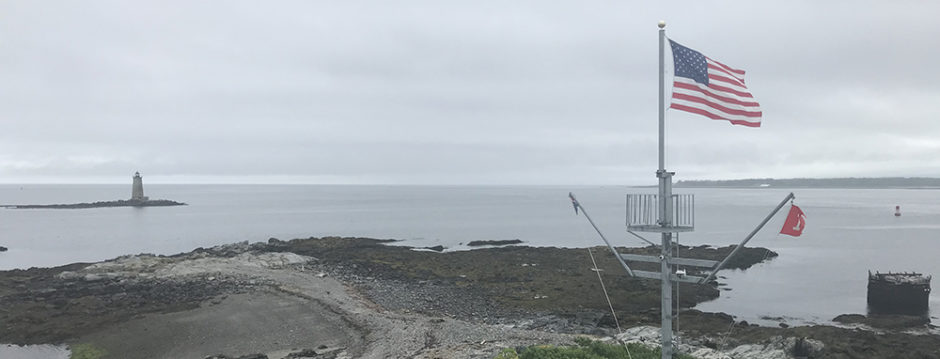On August 10-11, 2015, I climbed Mount Fuji on Japan’s first annual Mountain Day holiday. My article about this sunrise hike has just been published in the summer 2019 issue of Appalachia, with an excerpt here, along with more many more photos.
Outside, the wind shrieked, as if a massive gale had taken hold of the mountain. Inside the hut, the sounds of other hikers waking up – soft voices, the rustle of sleeping bags, the ripping of Velcro – rose around me in the darkness. On the sleeping platform, zipped into my bag and nestled in between my 15-year-old daughter Jen and a petite Japanese woman, I tried to rest a bit longer in my 16 inches of space.
The hutmaster had suggested rising at one a.m., but I thought we needed more rest, so I planned on a 2:30 a.m. wake-up. But now I couldn’t sleep. Although I didn’t want to wake Jen just yet, I squeezed out of my bag to get up for the bathroom.
I stepped into my hut slippers and outside into a thick mist and a dense crowd of humanity shuffling past the hut. Where had all these people come from? The wind had died down to a quiet whistle. Except for the crunch-crunch of boot-clad footsteps, the hikers moved quietly.
Looking up above the hut, I could see a line of white lights zig-zagging up the switchbacks of Mount Fuji’s cone. The line was continuous and unbroken, as if someone had strung a length of holiday lights up and across the dark mountain. The lights bobbed and shifted as invisible hikers climbed up the trail.
For several minutes, I waited to use the all-gender bathroom, where men urinated in the urinals while women, eyes averted, waited to use the stalls. In one stall, a hiker was vomiting, probably from the onset of altitude sickness.
After returning to our sleeping nest, I tried to rest, but soon realized that our host was right. With so many people crowding the trail, we had to start hiking if we wanted to reach the Mount Fuji summit in time for the sunrise. I woke up Jen. After dressing in the dark, we went downstairs to drink coffee and hot chocolate and eat a foil-packaged breakfast of rice and sardines. Not very appetizing, especially on a few hours rest, but we needed nourishment to power us up the mountain.
When we set out at 2:30 a.m., the air was still damp with mist, but the winds had dissipated. We stepped into the line of hikers with our small flashlights, although we didn’t need them because so many others had lights, creating a constant wave of low-level illumination. We began to hike with small steps, in sync with the others, a slow shuffle forward, the way the crowd moves as it exits Fenway Park after a ballgame.
The Big Dipper hung above us in the clear black sky. The temperature, by our New England standards, was mild, about 40 degrees F, perfect for hiking. Most hikers were clad in heavy coats, head-to-toe wind gear, hats and gloves, but we were comfortable in our long pants, a couple of light layers, and windbreakers, and we warmed up as we moved along.
We didn’t have to hike very far to the summit, just two kilometers, but the going was slow, partly due to the throngs of people on the trail and partly to the altitude — especially the rapid change from the day before, from Tokyo’s sea level to the 11,000 feet at the hut. I didn’t mind the slow shuffle, because the pace matched my fatigue. In the darkness, no one spoke. The only sound was the crunch-crunch of boots on volcanic scree. Moving with the crowd, I began to feel like we were part of something bigger than a hike.
When I planned this sunrise hike to Mount Fuji, I knew it would not be a wilderness experience. I knew that we would encounter many people and numerous food stalls on the trail, and that I would have to bring a hefty collection of 100 yen coins to use the bathroom (200 yen for each stop). But I accepted these conditions without complaining, because resenting the crowds could ruin the experience of climbing Mount Fuji.
What I didn’t know was that climbing a mountain with hordes of people offers its own rewards…..

Large groups of hikers set out to hike Mount Fuji on summer afternoons, leaving from the “5th Station” — about halfway up the mountain — and spending a few hours overnight in a mountain hut in order to reach the summit in time for sunrise.

A festive atmosphere prevails in the first kilometer of then hike. I have no idea what these figures represent — possibly Fuji bears? — but I’m guessing they are urging hikers to be safe.
At the end of our hike, covered with a thin film of volcanic dust, I fell asleep next to the parking lot for a few minutes before reviving enough to pay a short visit to the Komitake Shrine. Then we boarded the bus for the nearby resort town of Fujiyoshida,and dreamed of the soft beds awaiting us at our hotel.
To read more about my hike on Mount Fuji:
Subscribe to Appalachia, America’s longest-running journal of mountaineering and conserving, or order the summer issue at the Appalachia website.
For more on Japan, see my post, “Travels in Japan: French fries, pancakes, and pickled plums.” I got really busy with work the fall after my trip to Japan, and didn’t finish all my posts, but I hope to publish more about my Japan travels in the coming months. I was anxious about visiting Japan because it seemed like traveling there would be difficult, but it was so easy and I loved it!

































































